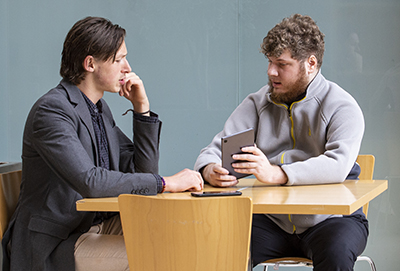
Two Oregon State University students are winning entrepreneurship awards as part of the team developing Alerty, a mobile app to help students — especially those with ADHD — perform better in class.
Most recently, the team won the Social Entrepreneurship Award at the TiE University Global Pitch Competition and was one of 30 teams to advance to the semifinal round, out of some 1,400 accepted into the competition.
Harry Herzberg, a senior in computer science, and Dmytro Shabanov, a senior in finance and marketing, are joined on the Alerty team by their business partners Jade Zavsklavsky, Artemis Kearny, Nicholas Craycraft, Alexander Victoria Trujillo, and Freya Crowe.
The Alerty app transcribes class lectures in real time to help students not only to review content, but also to see what they might have just missed.
Herzberg explained that students with attention-deficit/hyperactivity disorder may unintentionally lose focus in class and — because college courses are often fast-paced, with information that builds upon itself — quickly get left behind.
“I’ve had many classes where I’ve missed the teacher talking about the homework assignment, or a key point,” said Herzberg, who has ADHD. “Then I’m spending the entire day or even weeks trying to catch up, just because I missed that one important point.”
Herzberg got the idea for Alerty when he was in high school. His sister worked as a paraeducator who assisted students with learning disabilities by sitting with them in class, giving them one-on-one support.
“I wanted to make something that people would want to use as a tool, without drawing attention to themselves,” Herzberg said.
During the COVID-19 pandemic, when classes were being taught asynchronously online, Herzberg liked that he was able to go back and replay the lectures and absorb concepts he may have missed in real time.
“I was able to get better grades and even made the Dean’s List because I was able to go back and replay, slow down, and speed up the videos,” he said.
Alerty is a two-way street. The instructor must use the app in order for students to use it themselves. When the instructor makes an important point, they press a button on the app, which alerts students with a vibration on their phones or tablets. The app also highlights the corresponding part of the transcript in blue.
After class, students can review the lecture and, if necessary, select a portion of the transcript to ask the instructor for clarification. This feature also helps instructors to see where students are struggling over certain concepts.
The app can help many other students as well, including those who have different learning styles, English language learners, and those who have difficulty hearing.
In addition to the TiE award, Alerty earned second place in the College of Business’s Launch Academy competition, and a grant from the 1517 Fund.
Shabanov, who is responsible for the company’s business strategy, marketing, and financial planning, is working on obtaining additional funding.
Mike Bailey, professor of computer science, beta-tested Alerty in one of his classes during spring term. “For those who have difficulty focusing and taking notes in class, I think this could be a game-changer,” he said.



